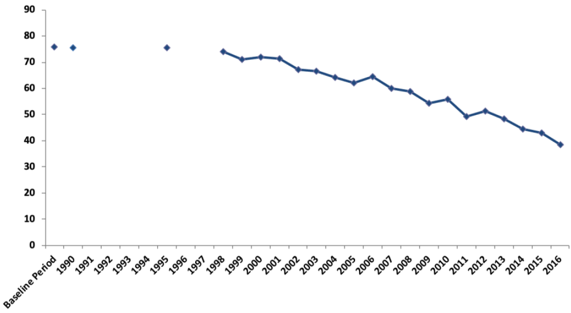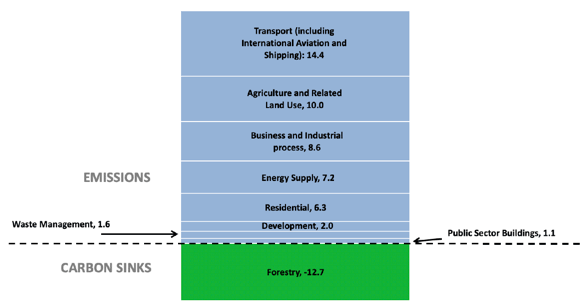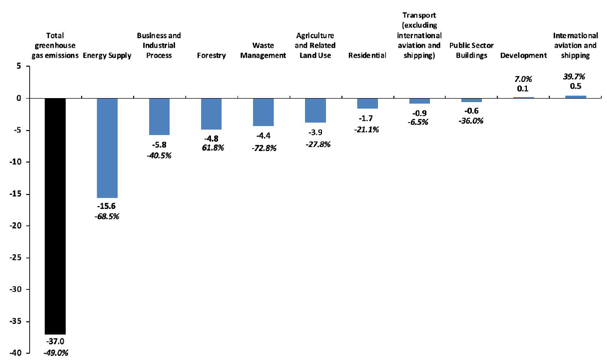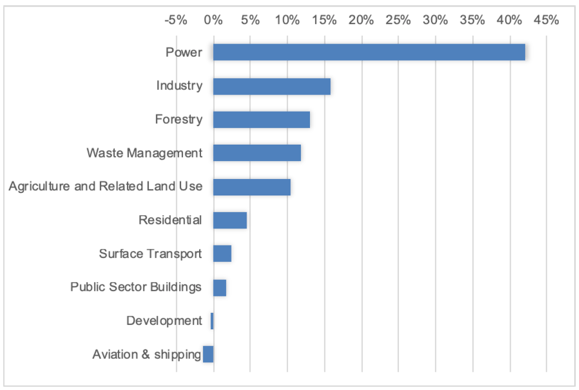Just Transition Commission: background report
Background information report on the Scottish economy to help inform the early deliberations of the Just Transition Commission.
7. Greenhouse Gas Emissions across Sectors
Summary of Evidence
Climate Change (Scotland) Act 2009, set a 2050 target of reducing greenhouse gas territorial emissions by 80%[78] and an interim target of 42% by 2020. Scotland also has annual targets for emissions reductions.
The Scottish Parliament is considering the Climate Change (Emissions Reduction Targets) (Scotland) Bill that proposes a 90% reduction target for 2050.
Scotland is performing well and met its annual legislated target for each of the past three years. Overall, Scottish emissions are now 49% below 1990 levels at 38.6 MtCO2e in 2016 (on an unadjusted basis).
The reduction has been achieved through declines in emissions from most sectors but the Energy sector decarbonisation has contributed most to this performance.
Transport (including Scotland's share of international shipping and aviation) is the largest emitting sector in 2016 accounting for some 37% of total net emissions. Agriculture is the next largest representing 26%. Scotland's forestry acts as a carbon sink contributing a 33% reduction to overall emissions, more than compensating for Agriculture. Business and Industrial processes account for just over a fifth, Energy Supply just under a fifth and Residential 16%.
Long-term Scenarios to 2050
Climate Change Committee's (CCC) 2018 assessment of Scotland's long-term ambitions considered the 80% emission reduction target achievable with the 90% reduction target also feasible but requiring further policy effort.
Policy Context
7.1. The Climate Change (Scotland) Act 2009, set a 2050 target of reducing greenhouse gas emissions by 80% and an interim target of 42% by 2020. The Scottish Parliament is considering the Climate Change (Emissions Reduction Targets) (Scotland) Bill which was introduced on 23 May 2018:
"The Scottish Government introduced the Climate Change (Emissions Reduction Targets) (Scotland) Bill to the Scottish Parliament in May 2018 following advice from the Committee on the definition and levels of the new targets. As introduced, the Bill would increase Scotland's ambition for emissions reduction by 2050 from 80% to 90% against 1990 levels, and adjust the way emissions are accounted for within the targets." [Reducing emissions in Scotland, 2018 Progress Report to Parliament, September 2018, page 6]
7.2. The targets in the Bill for 2020, 2030 and 2040, for reductions in emissions of 56%, 66% and 78%, are the most stretching statutory targets of any country in the world. Setting a 2050 target for a 90% reduction of all greenhouse gases means net-zero emissions of carbon dioxide. Scotland will be carbon neutral by 2050.
7.3. The Scottish Government has also said that it wants to go further and achieve net-zero for all greenhouse gases as soon as possible and that it will set a target date for this as soon as this can be done credibly and responsibly.
7.4. In light of the IPCC Special Report on limiting global warming to 1.5 degrees, the Scottish Government has joined the UK and Welsh Governments in asking the Committee on Climate Change for updated independent advice on targets. The Committee's advice is expected in Spring 2019.
The Evidence Base: Recent Trends
7.5. Scotland is performing well on reducing greenhouse gas emissions compared to the rest of the UK, and met its annual legislated target for each of the past three years. Overall, Scottish emissions are now 49% below 1990 levels (declining from 75.6 MtCO2e in 1990 to 38.6 MtCO2e in 2016)[79], and Scotland is on course to outperform the current interim target for 2020[80].
Figure 7.1: Scottish Greenhouse Gas Emissions, 1990 to 2016 (MtCO2e)

Source: Scottish Greenhouse Gas Emissions- Scotland 2016
7.6. Transport (including Scotland's share of international shipping and aviation) is the largest emitting sector in 2016 accounting for some 37% of total net emissions (14.4 MtCO2e). Agriculture and related land use is the next largest representing 26% of total net emissions (10.0 MtCO2e), although Scotland's forestry acts as a carbon sink contributing a reduction to overall emissions (-12.7 MtCO2e). Business and Industrial processes account for just over a fifth (22% or 8.6 MtCO2e), Energy Supply just under a fifth (19% or 7.2 MtCO2e) and Residential 16% (6.3 MtCO2e). Other sources Development, Waste Management and Public sector buildings together contribute a total of 12% of net emissions.
Figure 7.2: Sources of Scottish Greenhouse Gas Emissions, 2016 (MtCO2e)

Source: Scottish Greenhouse Gas Emissions- Scotland 2016
7.7. Since 1990, greenhouse gas emissions from all domestic sources have declined but the Energy sector has declined most and now contributes less than a third of its 1990 emissions. This has been due to the closure of a number of coal-fired power stations. The decline in Business and Industrial Process emissions (a reduction of 40.5%) is primarily due to a reduction in iron and steel emissions.
Figure 7.3: Change in Net Emissions by Scottish Government sector 1990 to 2016 - in MtCO2e and percentage changes

Source: Scottish Greenhouse Gas Emissions- Scotland 2016
7.8. Improvements in landfill management have contributed most to a significant proportionate decrease in Waste Management emissions (-72.8%) but this represents a net reduction of 4.4 MtCO2e. Domestic Transport has fallen but by only 6.5% and an increase in international aviation and shipping has meant that the sector as a whole fell by 0.4 MtCO2e.
7.9. The fall in Energy sector emissions between 1990 and 2016 accounts for 42% of the total decline in net emissions – more than twice the contribution than any other sector. Falls in the emissions of Business and Industrial Process, Forestry, Waste Management and Agriculture accounted for 51% of the decline in total net emissions.
Figure 7.4: Sector contributions to decline in Greenhouse gas emissions as a percentage of total net decline 1990-2016

Source: CPC calculations based on Scottish Greenhouse Gas Emissions- Scotland 2016 data expressed as a proportion of the total reductions achieved 1990-2016
7.10. Declines in the two other large emission sector – Transport and Residential were modest (a combined 6%). Effort is required across all sectors to meet future emissions reduction targets.
Contact
Email: Gregor.Auld@gov.scot
There is a problem
Thanks for your feedback